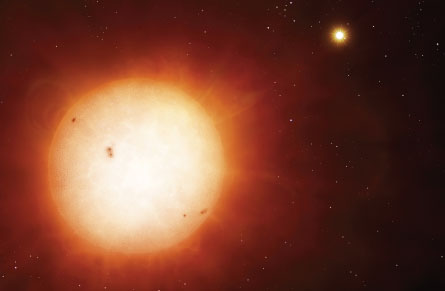Nemesis: Searching for the sun’s deadly companion star
Read the full article (PDF) | Vote on future topic | Search archives
September 1, 1984 | Vol. 126 | No. 9
Nemesis: Searching for the sun’s deadly companion star
If the sun is not a member of a binary or multiple star system, it is among the minority of stars. Yet if the sun has a companion, no one in thousands of years of observing has found it. It must be both distant and dim. A search for such a solar companion is now under way in Berkeley, Calif. Richard Muller, Jordin Kare and Carl Pennypacker of the Lawrence Berkeley Laboratory are using a telescope at the University of California’s Leuschner Observatory in the Berkeley hills, and are just completing their first series of observations.
They call the putative companion star Nemesis, after the Greek goddess of doom. The impulse to search for such a star now and the rationale for the name come from paleontology. Evidence recently put together seems to show mass extinctions of biological species at intervals of 26 million years. Why would this happen? One theory suggests that changes in living conditions are triggered by comets striking the earth after their motion was changed by an impulse due to the passage of Nemesis (SN: 4/21/84, p. 250).
…
From Kepler’s law, calculation shows that for an orbit of 26 million years, the semimajor axis of Nemesis’s orbit has to be 88,000 times that of the earth. Doubled, this gives 2.8 light-years for the major axis or longest dimension of the star’s orbit. That puts it closer than any known star to the sun, so Nemesis should show a larger parallax than any now known.
UPDATE | December 3, 2011
Seeking a friendlier companion
 Scientists once thought that the sun might have a stellar sibling (pair depicted here).
Scientists once thought that the sun might have a stellar sibling (pair depicted here).
Just two months after Science News introduced a proposed stellar companion named Nemesis, a follow-up story pointed to a series of papers suggesting that the theory might be “pretty well shot.” And pretty well shot, if not completely dead, is the status of this particular idea today: Several searches have ruled out the possibility of any unseen star-sized solar system bodies, and most people no longer think mass extinction events are periodic anyway.
But a paper published earlier this year in the journal Icarus has enlivened interest in a solar companion of a different sort. Two researchers from the University of Louisiana at Lafayette report that a planetary companion, up to four times as massive as Jupiter, might reside in the Oort cloud, an icy comet repository at the solar system’s edge. Unlike Nemesis, this body — dubbed Tyche, for “good fortune” — would be more friend than frenemy. Tyche’s mass would be less, and the planet’s orbit more circular, making any interaction with Earth far from catastrophic. And instead of hurling destructive comets toward Earth where they could do away with terrestrial life-forms, Tyche would simply shepherd the bodies into the nonrandom orbits that some researchers believe they observe among long-period comets.
No strong Tyche candidates have yet been uncovered, but data from the Wide-Field Infrared Survey Explorer, a satellite that could detect such a body, are planned for release in the spring. The catalog will probably contain hundreds of millions of detections that will take the astronomy community months or years to sift through, says Davy Kirkpatrick, a WISE mission scientist. —Elizabeth Quill
Credit: Mark Garlick/Photo Researchers